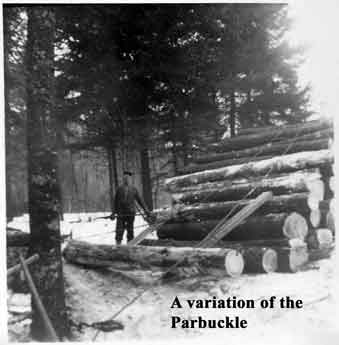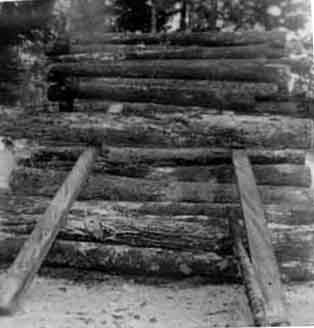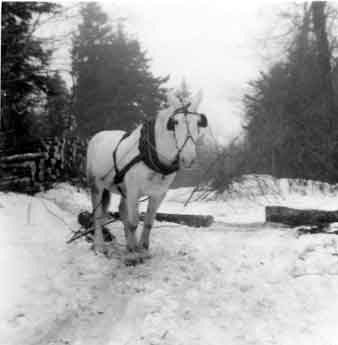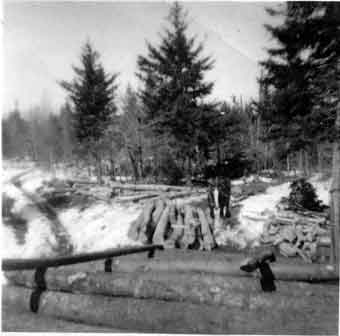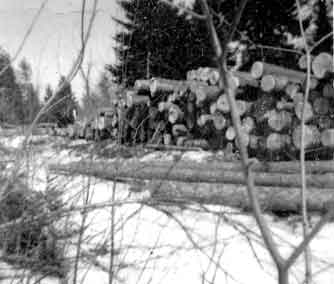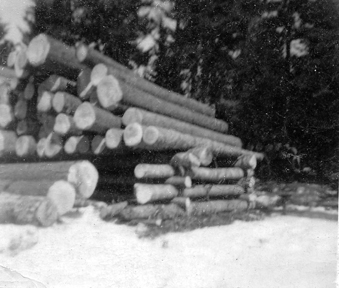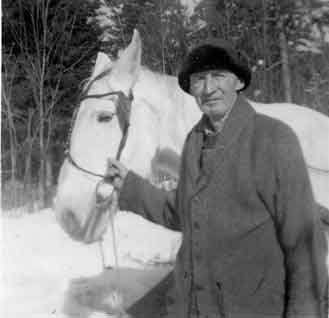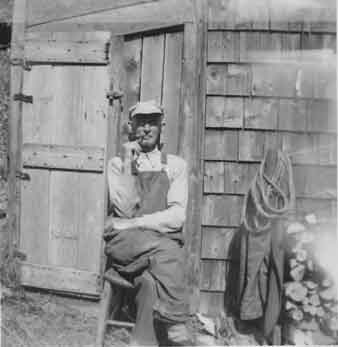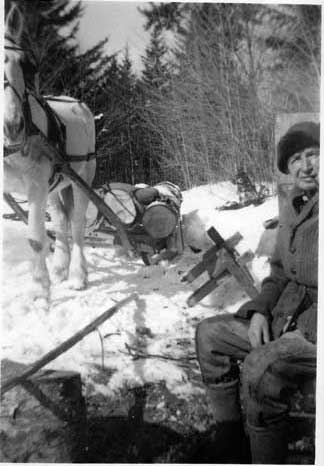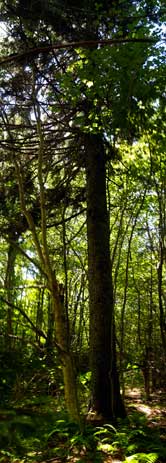My father’s Red River Timberland in the Early 1950,s
Each photograph displayed below is a thumbnail or link to a larger version of the photograph as well as other images. Simply place the cursor over a photograph and single click.
Introduction
I became interested in the technology of water powered sawmills in 2011 when I discovered the remains of an early water mill located on a Bay of Fundy salt marsh. At that time I assumed that water powered sawmills existed in Britain as far back as the medieval (Barnes, 1996) period and that seventeenth century English speaking colonial settlers transferred watermill technology from the Britain to the Atlantic coast of North America. Research, however, showed that “Surprisingly the first sawmills of the New World trace their origin directly to continental Europe rather than to Britain” . Research also led to publications promoting the view that the hostility of the pit sawyers prevented, as shown in the quote below, the development and use of pre-steam age sawmills in Britain (Smiles, 1863). “The first saw-mill in England was erected by a Dutchman, near London, in 1663, but was shortly abandoned in consequence of the determined hostility of the workmen. More than a century passed before a second saw-mill was set up; when, in 1767, Mr. John Houghton, a London timber-merchant, by the desire and with the approbation of the Society of Arts, erected one at Limehouse, to be driven by wind. The work was directed by one James Stansfield, who had gone over to Holland for the purpose of learning the art of constructing and managing the sawing machinery. But the mill was no sooner erected than a mob assembled and razed it to the ground. The principal rioters having been punished, and the loss to the proprietor having been made good by the nation, a new mill was shortly after built, and it was suffered to work without further molestation.” Sawmills appeared in Europe long before the timber-merchant John Houghton erected his sawmill in 1767. Lucas (Lucas, 2006) states that “Sawmills are first unambiguously recorded in the European sources in France in the beginning of the fourteenth century, even though the earliest illustration of one is by Villard de Honnecourt from c. 1234. The earliest French references to the use of sawmills in the Dauphine suggests that there was already a well–developed sawmilling industry there by at least the 1280s, and probably earlier. It would therefore seem that water-powered sawmilling was well established in France by the late thirteenth century, and in Italy by at least the fourteenth or early fifteenth century. The precise nature of the mechanism or mechanisms remains somewhat of a mystery, however.” John Houghton was a timber-merchant, suggesting, possibly, that Britain had a shortage of timber suitable for cutting into “saw logs”. Cooney (Cooney 1991, 1998) has written on this possibility and he states that “resort to sawmilling in Britain was hindered by a gradually increasing and widespread scarcity of timber, especially in the form of substantial forests and plantations, a difficulty not common on the Continent – although the districts of Holland where sawmills were established seem to have relied on imports.” So it is possible that Britain never had vast areas of trees that could be cut into long straight logs suitable for mill sawing. It is difficult to mount a curved log on a mill carriage. As well, it may have been difficult for early water powered sawmills to saw hardwood logs, England’s oak trees for example. Colonial sawmills in North America were erected because the settlers found suitable tall straight hardwood and softwood trees in the so called Acadian Forest Region of North America and in the Boreal Forest Region of North America and Northern Europe. Not only are these trees tall and straight, they have, if located in an old growth forest, no limbs on a substantial length of the bottom section of the tree. The question can be raised: were such trees available in Britain when sawmill technology was developing? I have assembled a collection of photographs showing my lumbering experience gained while growing up on the Parrsboro Shore on the Upper Bay of Fundy in Nova Scotia. This experience was gained because I worked (on weekends) with my father on a small acreage of forest land that he inherited from his father. Our land was part of the so-called “Acadian Forest Region”, a region comprising all the Maritime Provinces, New York, New Hampshire, Vermont and Maine. My search for the mechanism by which water mill technology was brought to North America’s Atlantic Coast is colored by this experience in my father’s timberland and in summer jobs in one of the last steam powered sawmills in Nova Scotia. Acadian Forests are a mixture of coniferous and deciduous trees. Both tree types provided my family’s business with logs and long span timbers. The deciduous trees also provided fire wood for winter. In the early 1950’s many of the trees on my father’s timberland were large enough to be cut into saw logs. At that time power saws were becoming affordable and with such a tool and a borrowed horse my father was able to do all of the lumbering by himself. It took two winters and on the weekends I would use the horse to drag the logs he had cut to a large pile called a brow. The dragging process was over a hard snow path and was called yarding. And the horse, in the winter time, was called a yarding horse. It was great fun for a fourteen year old boy. References Barnes, C. F. (1996). Villard de Honnecourt. Macmillan Dictionary of Art London. 32: 569-571 Retrieved 18 November 2013 from http://www.villardman.net/diction.html Cooney, E. W. (1991). "Eighteenth Century Britain's Missing Sawmills: A Blessing in Disguise?" Construction History 7. Retrieved 18 November 2013 from http://www.constructionhistory.co.uk/journal.php?mode=details&jid=108 COONEY, E. W. (1998). "Eighteenth Century Britain's Missing Sawmills: A Return Visit1." Construction History 14. Retrieved 18 November 2013 from http://www.arct.cam.ac.uk/Downloads/chs/final-chs-vol.14/chs-vol.14-pp.83-to-87.pdf Foreman, B. M. (1970). "Mill Sawing in Seventeenth-Century Massachusetts." Old-Time New England Journal 60(No.220): 110 - 130.Retrieved 25 November 2013 From http://hne-rs.s3.amazonaws.com/filestore/1/2/8/0/0_743f3ba38c50e98/12800_43708f204bfc452.pdf Howell, C. (1975). Colonial Watermills In the Wooden Age Terrytown,N.Y., Sleepy Hollow Restorations, Inc., chartered by the Board of Regents of the University of the State of New York, p. 64 Riznik, B. (1965). Old Sturbridge Village Documents - New England Village Sawmills, 1790-1840. Sturbridge, Massachusetts, USA, Old Sturbridge Village, Old Sturbridge Inc. Retrieved 25 November 2013 From http://resources.osv.org/explore_learn/document_viewer.php?Action=View&DocID=1071 Smiles, S. (1863). "Industrial Biography: Iron-workers and Tool-makers." p. 322, first edition, Retrieved 18 November 2013 from http://www.freebookstoread.com/inbio10_322.htm. Lucas, A. (2006). Wind, Water, Work:Ancient And Medieval Milling Technology , Technology and Change in History, Vol. 8. Boston, Brill. P. 262 For a review of this important book see http://muse.jhu.edu/login?auth=0&type=summary&url=/journals/technology_and_culture/v048/48.4mazzotti.html
|

